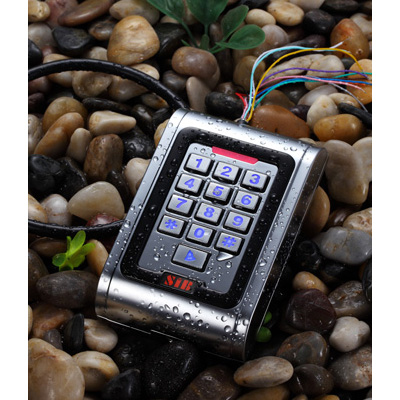H.264 is the latest trend in video surveillance. While its advantages such as bit rate reduction, transmission resiliency and high video quality are demanded everywhere, a customized solution enables a more cost-effective and operationally efficient installation.
H.264 is the latest trend in video surveillance. While its advantages such as bit rate reduction, transmission resiliency and high video quality are demanded everywhere, a customized solution enables a more cost-effective and operationally efficient installation.
In 2009, the size of the global DVR market is projected to be US$2.5 billion, 31.3 percent of which would come from the EMEA region, said Raymond Weijts, EMEA Product Marketing Manager at Bosch Security Systems. The Americas and APAC account for the rest 30 and 40 percent, respectively, said Sven De Bie, Software Marketing Manager, Media Processing at NXP Semiconductors, predicting that from 2010 on growth will primarily be in network-based DVRs.
IMS Research forecasted that the global DVR market will grow at approximately 10 percent each year in terms of revenue over the next five years. The fastest growing region will be Asia, mainly due to the rapidly expanding Chinese market, said Alastair Hayfield, Market Research Analyst, Security and Fire, IMS Research.
H.264 DVRs are generally suitable for brand new sites, said James Lee, GM of International Marketing and Sales at Artnix. Popular applications include shopping centers, financial institutions, public monitoring, crowd surveillance, casinos and hotel complexes, Weijts said.
"Installations that require integration with PCs or other security systems could use PC-based DVRs," said Wells Shih, VP of Sales at Chateau Technical, "whereas embedded DVRs would be best for installations that require specific features."
 Today, earlier versions of MPEG-4 are dominating the market because H.264 is still a relatively new compression standard. However, Tony Chiu, Director of R&D for iCatch, estimated for the second quarter of this year, the market size for H.264 will be as big as the one for MPEG-4, as its H.264 DVR sales increased to two times more than its MPEG-4 DVR's during the second half of 2008.
Today, earlier versions of MPEG-4 are dominating the market because H.264 is still a relatively new compression standard. However, Tony Chiu, Director of R&D for iCatch, estimated for the second quarter of this year, the market size for H.264 will be as big as the one for MPEG-4, as its H.264 DVR sales increased to two times more than its MPEG-4 DVR's during the second half of 2008.
H.264 is the answer for efficient data transmission and high-quality video storage, said Shih. It is predicted to be the market trend for the next four to five years.
Latest Technology
IP surveillance, remote management and high-definition (HD) cameras are currently in demand in video surveillance, said Bie. Needs for H.264 products have increased because they support megapixel cameras and deliver the same or higher quality images as MPEG-4 or M-JPEG products while requiring less storage and bandwidth, said Mark Bowles, Project Development Manager at Quick Solutions.
Timestamp in DVRs is important, for forensic and evidentiary purposes. Implementing this feature into H.264 DVRs without compromising the overall stability and compatibility should be developed, said Steve Hu, DVR and Camera Development Manager at Merit LILIN.
Video analytics could be added to H.264 DVRs and cameras to improve highway management, enforcing traffic laws and analyzing traffic flows. "Ipsotek, a spin-off from the University of Kingston is a key player based in United Kingdom," said Bie.
 DSP is currently the most widely used chipset by H.264 DVR manufacturers, as it is programmable (with easy CODEC configurations and updates) and suitable for those complicated, intelligent features that cannot be achieved through hardware compression, said Sunny Lee, Business Development Director, Catalog DSP/EEE Products, Asia SC Market Development, Texas Instruments.
DSP is currently the most widely used chipset by H.264 DVR manufacturers, as it is programmable (with easy CODEC configurations and updates) and suitable for those complicated, intelligent features that cannot be achieved through hardware compression, said Sunny Lee, Business Development Director, Catalog DSP/EEE Products, Asia SC Market Development, Texas Instruments.
While ASICs have lower power consumption that work well with small to medium-sized systems, DSP is flexible with improved interoperability that supports emerging standards of any image resolution, multichannel and CODECs . Although the R&D process is more complicated and of higher cost in the initial development period, implementing DSP-based solutions allows for shorter time to market and make products more competitive with differentiated features. When the system needs to support more than four channels, DSP would be a better choice because of its higher computing power, said Shih.
Some H.264 DVRs can only offer retrieval of images through management software. However, DVRs with dual CODECs can continue to support independent streaming of recordings and live transmissions. Remote surveillance is also available in some H.264 DVRs.
For storage, RAID can be optimized for better performance. "The parity drive in standard RAID setup would be a bottleneck in high I/O situations, but the optimized RAID setup could evenly spread workload on the disk and ensure smooth performance," Weijts said.
Selection Criteria
System stability, component quality and tailored features are the top considerations when integrators or installers choose H.264 DVRs. While users want high-quality images, low price with extended recording hours, storage redundancy and channel scalability are also on their wish list. Solutions need to be highly tailored to different needs. "DVRs should be tested at temperatures above 70 degrees Celsius, ensuring operation in harsh conditions," said Bowles.
 A DVR's hard-drive disk must be able to read and write smoothly to ensure a longer lasting storage system, said Tony Yang, International Marketing Director for Hikvision. In order to keep the system stable, Hu said, power supplies, cable lines and motherboard layout should be designed such that electrical interference to the hard drive and video streaming is minimized.
A DVR's hard-drive disk must be able to read and write smoothly to ensure a longer lasting storage system, said Tony Yang, International Marketing Director for Hikvision. In order to keep the system stable, Hu said, power supplies, cable lines and motherboard layout should be designed such that electrical interference to the hard drive and video streaming is minimized.
How many channels an H.264 DVR supports is closely linked with how well its CODEC compresses video signals. "The higher number of channels the H.264 CODEC supports, the lower the cost and the easier the system design can be," said Tom Krause, VP of Business Development for Techwell.
Moreover, DVR platforms must be highly flexible for integration with access control, intrusion and fire detection systems, as a centralized control center can further help users manage security breaches more efficiently, said Weijts. The CODEC platform must be well designed and have high compatibility with both analog and network cameras to ensure smooth transition, said Yang.
Image processor's IC design should fit specific requirements of each installation, said Shih. Although manufacturers list their technical specifications, dealers and users should still verify and test the product's actual performance to avoid misinterpretation of technical descriptions.
Challenges
The biggest challenge in promoting H.264 is market adaptability. Users expect systems to be able to record high-quality video for a long time, but they are generally not very concerned about specific compression standards, said Bowles. Prices for storage devices have fallen rapidly in recent years, making it much cheaper for users to add additional storage than to improve compression efficiency.
 User education is another challenge. Although H.264 is the current market trend, its image quality differs when H.264 algorithms are implemented differently in encoders. The myth that H.264 by definition stands for better image quality is not always true, Weijts said. What differentiates DVRs is the way in which the toolset of H.264 is implemented. "H.264, when compared to MPEG-2 and MPEG-4, has a more powerful toolset which can — when implemented correctly — offer better image quality at the same bit rate or offer the same quality at a lower bit rate," said Weijts. Systems are more efficient when compression toolsets are implemented better.
User education is another challenge. Although H.264 is the current market trend, its image quality differs when H.264 algorithms are implemented differently in encoders. The myth that H.264 by definition stands for better image quality is not always true, Weijts said. What differentiates DVRs is the way in which the toolset of H.264 is implemented. "H.264, when compared to MPEG-2 and MPEG-4, has a more powerful toolset which can — when implemented correctly — offer better image quality at the same bit rate or offer the same quality at a lower bit rate," said Weijts. Systems are more efficient when compression toolsets are implemented better.
Determining the right feature sets at the right price to ensure a compelling and differentiated product offering is also a challenge, said Jorg Tilkin, Product Line Director at Xtralis Security Solutions. A full-featured base model with modular options could customize the system and make it more cost-effective.
Future Outlook
As needs for system integration and surveillance over IP increase, H.264 DVRs need to evolve to have onboard video analytics, the ability to support domestic DVD players and flexible IC design. The system must also be able to integrate with other physical security systems and support industry standards to ensure its long-term marketability.
Analytics in residential, industrial automation and automotive applications would increase, said Bie. Popular applications include door entry systems and presence detection for energy saving in home automation; gateless entry systems, presence detection and quality inspection for industrial automation; and lane departure detection, automated parking and collision avoidance for automotive. These all require HD video signals, which can be rendered by H.264 DVRs.
For viewing convenience, compatibility between H.264 and domestic DVD players  might also be needed, Hu said. "MPEG-4 cannot be played by household DVD players like MPEG-2, but it doesn't mean users don't have such needs," said Hu. "Although MPEG-4 signals could be converted back to MPEG-2 and be played by domestic DVD players, such converters can be hard to find and cost a lot." A more cost-effective way is to develop standards, making it compatible with all video players.
might also be needed, Hu said. "MPEG-4 cannot be played by household DVD players like MPEG-2, but it doesn't mean users don't have such needs," said Hu. "Although MPEG-4 signals could be converted back to MPEG-2 and be played by domestic DVD players, such converters can be hard to find and cost a lot." A more cost-effective way is to develop standards, making it compatible with all video players.
Interoperability between streaming protocols and server file systems is another important factor to consider, said C. J. Liang, GM at Grain Media. "High-speed serial ports for video I/O and multichip linking are in demand as users are looking for systems that can support more camera channels of HD resolution, and keep chip power in reasonable order." Standardizing cameras, analytics and DVR/NVR protocols would help move the industry forward more rapidly, said Tilkin.
In terms of IC design, Joe Hanson, Director of Business Development for APAC at Stretch, sees low-cost, low-margin and low-channel count embedded DVRs using ASICs/SoCs to reduce the cost for D1 models, but sees programmable solutions forming the basis for products with higher channel counts and differentiated values. Michael Chiu, President at Genistech Solutions, suggested that ASICs and DSPs would coexist and process data interchangeably in the future.
More compression standards will definitely continue to emerge. A new standard, H.264 SVC, was set in the beginning of 2008, said Hanson, replacing dual streaming with a secondary stream that can be transmitted over the network for remote monitoring. Integrated mobile DVRs for car surveillance are going to be realized by Japanese automobile manufacturers in the near future to provide total proof for car accidents, said Chiu from Genistech Solutions.